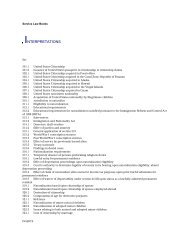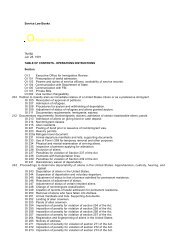Create successful ePaper yourself
Turn your PDF publications into a flip-book with our unique Google optimized e-Paper software.
<strong>Inspector's</strong> <strong>Field</strong> <strong>Manual</strong><br />
Local ports tend to have patterns for the types of documents encountered which are most likely to be fraudulent.<br />
Birth and baptismal certificates, which have no national standards, are the most commonly counterfeited,<br />
altered, or improperly issued documents. Familiarize yourself with security checkpoints of documents<br />
regularly presented at your port-of-entry.<br />
(b) Counterfeit or altered document. Alteration of documents occurs in several ways: changing data on a valid<br />
document to fit the description of the alien applicant, photo substitution, and page substitution are the most<br />
common. Counterfeiting of birth records and other similar documents is also commonplace, counterfeiting of<br />
entire passports happens less frequently. Some attempts are excellent, others fairly crude. Always examine<br />
documents with laminated photos, such as border crossing cards, outside any case or holder so you can feel any<br />
relamination. This is a good practice, even at land border primary locations. Familiarity with document alerts<br />
and passport studies provided by the Intelligence Division will also make detection of this type of fraudulent<br />
document easier. Following are tips for passport examination.<br />
- Examination of a passport begins with the cover. Look for the quality and clarity of printing, color,<br />
thickness and even spelling. Check the shape and cut of corners.<br />
- Next inspect the inside pages for known watermarks and background printing, as well as any other<br />
known security checkpoints. Again, examine spelling and print quality. Check the alignment of pages and the<br />
shape and cut of corners. Perforations should generally be sharp, distinct and evenly aligned.<br />
- Review the data page or pages of the document. Handwritten entries should be made with the same<br />
color ink, without overwritten or blotched entries. Typed entries should all be with the same typeface and<br />
consistency of ink.<br />
- Examine the photo page for signs of double lamination, cuts in the lamination, excessive glue, or<br />
wrinkling. Inspect wet or dry seals overlapping the photo. Seals should be aligned and distinct. The seal<br />
impression on the reverse side of the page should match that of the front.<br />
- Examine the page immediately opposite the photo page for grommet or staple indentations. Such<br />
indentations should match the grommet or staple attaching the photo.<br />
- Examine the binding for jagged or enlarged stitching holes. Stitching should be evenly spaced.<br />
(c) Genuine document presented by imposter. Careful questioning of an applicant regarding the nature of the<br />
visit and the particulars of how the visa was obtained, and close scrutiny of the photo and biographic data on<br />
the travel document will assist you in determining if the bearer is the rightful holder of the passport or visa.<br />
Immigration officers have delegated authority, pursuant to 22 CFR 41.122(h) to cancel genuinely issued visas<br />
which have been removed from the original travel document or which are presented by other than the rightful<br />
holder. Whenever such action is taken, prepare Form I-275 to advise the issuing consulate.<br />
(d) Genuine document obtained by fraud. Among the more difficult tasks you face as an inspector is making a<br />
determination that a passport, visa or, other document issued by competent authority was based on a<br />
fraudulent application or agency error. While it is not possible for you to readjudicate the underlying basis of<br />
eligibility for every document presented, you should be aware of the general requirements for various<br />
immigration benefits and know what relevant questions to ask an applicant for admission when you become<br />
suspicious. As INS automated systems improve, you have at your disposal more information from agency files<br />
upon which to inquire. Access to INS automated systems is discussed in Chapter 31. Your observation of the<br />
applicant's demeanor and his or her responses to simple questions are the best tool for uncovering this type of<br />
fraud.<br />
17.4 False Claims to U.S. Citizenship.<br />
(a) General. You must always be alert to the possibility that an alien may attempt entry by falsely claiming<br />
United States citizenship. The claim may be either an oral claim or one supported by an authentic or fraudulent<br />
document. The best defense against false claims to U.S. citizenship is your own instinct as an inspector. The<br />
most obvious clues in detecting a false claim are nervous actions or reactions on the part of the applicant or<br />
language patterns that don't fit the claim to citizenship. If the response to the question, "Of what country are you




